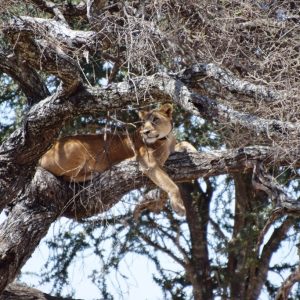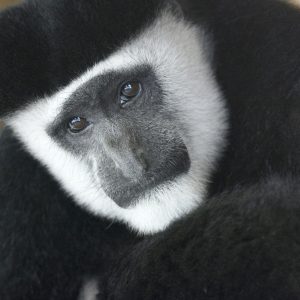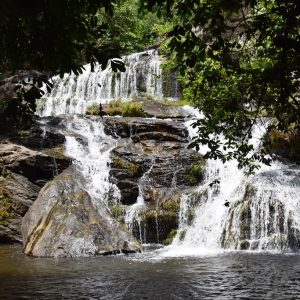6 Days Kilimanjaro Marangu Route (5 days possible)
- Offers the luxury of sleeping in huts
- It’s an easier climbing route with very few steep climbs, commonly known as the “Coca-Cola route”
- The slight incline makes this route attractive for everyone with less hiking experience, but it doesn’t allow much time for acclimatization
Tour FAQs
- Overview
- Itinerary
- Circuit / Region
- Included Services
- Excluded Services
- Options
- Rates
- Best Time To Travel
- Packing Tips
- Notes
The Marangu Route is one of the easier routes to the summit of Kilimanjaro and the shortest, but you shouldn’t underestimate the altitude. It has well developed paths and less steep sections, which lead through a beautiful landscape of rainforest, heath and desert landscapes to the glacier zone. If the weather is fine you can enjoy beautiful views of Mawenzi and Kibo peaks. However, the possibility of acclimatization is less than on other routes and many have had to turn back because of altitude sickness.
The route can be done in 5 days, but 6 days are advisable because of the better acclimatization. This route is a good option for those with no camping experience or who don’t like camping, because it is the only route that has the luxury of sleeping huts along the way with evening meals taken in a communal dining area. There are even showers (cold) and some flush toilets. This is, why this route is also called the ‘Coca Cola’ Route.
Short Overview
Day 1: Marangu Gate to Mandara hut
1.800m/5,905ft - 2.743 m/9,000 ft
Elevation Gain: 915 meters, 3,000 feet
Day 2: Mandara Hut to Horombo Hut
2.743m/9,000ft - 3.720 m/12,200 ft
Elevation Gain: 977 meters, 3,200 feet
Day 3: Horombo Hut via Mawenzi hut to Horombo Hut
3,720m/12,200ft via 4.600 m/15,100 ft - 3.720m/12,200ft
Elevation Gain and Loss: 880 meters, 2,900 feet
Day 4: Horombo Hut to Kibo Hut
3.720m/12,200ft - 4.750 m/15,580 ft
Elevation Gain: 1.030 meters, 3,380 feet
Day 5: Kibo Hut to Summit to Horombo Hut
(4.750m/15,580ft - 5.895 m/19,340 ft - 3.720m/12,200ft
Elevation Gain: 1.145 meters, 3,760 feet
Elevation Loss: 2.175 meters, 7,140 feet
Day 6: Horombo Hut to Marangu Gate
3.720m/12,200ft - 1.800 m/5,905 ft
Elevation Loss: 1.920 meters, 6,295 feet
Detailed Itinarary
- Day 1: Marangu Gate to Mandara Hut
(hiking time: 3 – 4 hours)
Leave Arusha or Moshi for Marangu Gate. After your mountain guide has completed the registration, you start your trekking with the first 3 to 4 hours stage to the first hut. For most of the hike you walk along a narrow trail through the rainforest. After having a picnic lunch halfway, you continue hiking through the rainforest to the Mandara hut. You can relax for the rest of the day or take a short walk of 20 minutes to Maundi Crater. On clear days the views to the east over Taveta and to the northwest to Mawenzi Peak are stunning.
The A-frame Mandara Huts can accommodate up to seventy people and consist of several sleeping huts and a dining area. All Marangu huts have beds with mattresses. - Day 2: Mandara Hut to Horombo Hut (hiking time: 5 —6 hours)
After the first night on the mountain and a relaxed breakfast you leave Mandara hut for Horombo hut. Today's stage takes you through heath and moor landscape, a rocky landscape with desert-like plants. Picnic lunch will be at Kambi ya Taabu before continuing to Horombo hut. If the weather is clear, you have a wonderful view of Mawenzi peak, the second peak of the Kilimanjaro. Shortly before your arrival at the Horombo hut at about 3 p.m., you will see the first giant Senecias and giant lobelia. Spend the rest of the afternoon relaxing.
Although extremely busy, the Horombo Huts are considered the nicest on Kilimanjaro. The small, A-frame buildings can accommodate up to eight people each and provide lodging for hikers ascending, descending and acclimatizing. Horombo can accommodate up to one hundred hikers and many more porters, cooks and guides. - Day 3: Horombo Hut via Mawenzi Hut to Horombo Hut (Acclimatization day)
Day three is an acclimatization day. We recommend hiking to the Mawenzi hut and back to Horombo hut to allow maximum acclimatization. The hike increases your chances of reaching Uhuru Peak and rewards you with a wonderful view of Kibo. Return to Horombo Hut for a late lunch. Spend the afternoon and evening in Horombo. - Day 4: Horombo Hut to Kibo Hut
(hiking time: 5 – 6 hours)
Leave Horombo Hut after breakfast to hike through the moorland and alpine desert of Kilimanjaro’s upper altitudes. Today you have two options to get from the Horombo hut to the Kibo saddle. The direct route to the Mawenzi saddle (Upper Trail) is very rocky and washed out. The ascent to the saddle takes about 2 hours and then another three hours to the Kibo hut. The so-called Lower Trail is easier to walk. It leads slightly up through a shrub landscape and upland moor. Approx. 1 hour before the Kibo hut you will reach the saddle. The environment is now changing noticeably, it is rocky and rough and more and more resembles a stone desert with red-brown earth. You will reach Kibo Hut around 3 p.m. to rest and prepare for your midnight climb. - Day 5: Kibo Hut to Summit and descend to Horombo Hut
(hiking time: up 6 - 8 hours, down 5 - 6 hours)
Wake up around midnight for the final ascent to Uhuru Peak, the roof of Africa. After a five-hour hike with a rest at William's Point, about two hours from the Kibo Hut, you reach Gilman's Point at 5.681 m on the crater rim with the first rays of sunshine. The glittering red sun reflects the ice fields and the rugged peaks of the Mawenzi. Although this is considered the easiest of the three crater ascent paths, it is still extremely difficult.
The hike from Gilman's Point to Uhuru Peak is a gradual climb and not very difficult. However, the altitude makes the hike long and tiring. The crater rim hike takes about two hours. After reaching Uhuru Peak enjoy this magnificent moment on the roof of Africa! Then take photos of your guide and group before descending to the Horombo Hut.
On the way down from the summit, you will see all the magnificent views you couldn’t see on the way up. Stop for a short break with some snacks at Kibo Hut before continuing to Horombo Hut. Reach Horombo Hut in the afternoon and enjoy your last night on the mountain. - Day 6: Horombo Hut to Marangu Gate
(hiking time: 6 - 7 hours)
The last day of your hike starts with a relaxed breakfast. Well-strengthened you can start the last stage of your hike. The path leads again through lush green mountain rainforest. Before leaving the national park, the traditional farewell ceremony takes place. Once you arrive at the Gate your summit certificate will be issued, and now it is time to say goodbye to the mountain and your team.
- Transport from and to your hotel/residence or Airport/seaport
- Private English-speaking Professional mountain guides
- Guides, Porters, cook salaries
- All park & Camp fees
- Rescue fees
- All meals while on the mountain incl. filtered Water, tea & coffee
- Government taxes, VAT and All relating service charges
- First Aid Kit and summit Oxygen
- Hot Water for washing
- Emergency evacuation by Flying doctor
- International/national flights and visa fees
- Tips for guides and support staff
- Sleeping bag, mat and personal items for the hike (please have a look at our packing list). Almost all equipment is available to rent from our team in Tanzania if required.
- Bath towels
- Private portable toilet and privacy tent
- Personal expenses (airport taxes, Internet, soft and alcoholic drinks, snacks, laundry etc.)
- Government-imposed increases in taxes and/or park entrance feess
- Anything else not mentioned in the inclusions
- This route can be done in 5 days but it is advised to take an extra day for acclimatization
- On request other tour languages possible
- Additional accommodation before and after the tour can be arranged for an extra cost
- Extension of the tour or an additional program is possible or have a look at our other offers
- Between January and March the temperatures are mild, the weather in the morning and afternoon is nice and the visibility of the mountain is particularly good
- In June and July the sky is clear and the nights are cold
- August, September and October are the warmest months to climb Kilimanjaro
- Rainy season: Late March to mid-May and November and December. There is snow in the higher elevations
Please follow the list below to ensure your comfort. You will have a better vacation if you are prepared.
But please note that this list is not exhaustive!
Almost all equipment is available to rent from our team in Tanzania if required. Please talk to us in advance for further planning.
The climb to the summit of Kilimanjaro leads through four climatic zones. Therefore, the weather can range from warm and tropical at the base of the mountain to freezing on the summit and the temperatures can range from + 20 ° C down to -15 ° C.
Cotton should be avoided as it is hydrophilic, which means it absorbs moisture and blocks breathability.
Since June 1, 2019, Tanzania has been banned from using single-use plastic bags. If you want to separate items in your bag, please use re-usable "packing cubes". Please also note that disposable plastic bottles are not permitted on Kilimanjaro.
Please note that your large backpack can weigh a maximum of 20 kg. This is the maximum permissible weight that a porter can carry. This weight limit is checked at the hotel pickup.
To carry your most important belongings with you, a 20 - 40 l daypack is best. You should pack your backpack very carefully and not carry too much with you, because at altitude you need all the strength for your ascent.
Basic Equipment
- Daypack 30 – 40 L (for your personal belongings, you need to carry it yourself) + rain cover
- Duffle bag or backpack (60 – 80 L / maximum weight 20 kg/carried by the porter) + rain cover
- Sleeping bag (possible to hire from our team in Tanzania)
- 1x mat/sleeping pad – to protect from hard and cold underground (possible to hire from our team in Tanzania)
- Trekking poles
- Water bladder/bottles for 3 liters of water (please remember disposable plastic bottles are not permitted)
CLOTHES
Head
- Warm hat
- Sun hat
- Scarf
- Sunglasses with high UV protection
- Headlamp (for summit night and toilet) with extra batteries
Hands & Feet
- 1 x light gloves
- 1 x winter gloves (summit day)
- Waterproof Hiking boots (they should fit well, with lots of room for the toes, and are well worn in before starting the trek)
- Training shoes (for the camp)
- Outer socks, liner socks and one pair of thermal socks for summit day
- Gaiters (protection against the ingress of rubble and moisture / not particularly necessary)
- Micro-spikes (possible to hire from our team in Tanzania)
Upper body and legs
- Fleece or softshell jacket
- Hard shell outer jacket (for protection against rain and wind)
- Poncho (recommended if climbing during raining season April/May and November
- Fleece pullover
- Long and short sleeve hiking shirts
- Functional sports underwear
- Thermal or fleece leggings
- Light or medium trekking pants
- Hard shell pants (waterproof/windproof)
POSSIBLE CONTENT of a PHARMACEUTICAL TRAVEL KIT
- Plasters & blister plasters, tapes, bands, cotton, alcohol
- Medicine against diarrhea, nausea, headache, stomachache, altitude sickness, Malaria
- Painkillers
- Personal medication
- Nasal spray
- Antiseptic ointment
- Electrolytes (to avoid dehydration in case of high fluid loss)
- Contact lenses cleaner
- Insect repellent
MISCELLANEOUS
- Sunscreen with High SPF and lip protection balm
- Packing cubes (for organizing the items in the duffle bag)
- Personal snacks (e. g. cereal & energy bars, nuts, isotonic drink powder, chewable vitamin tablets with dextrose)
- Ear plugs
- Toilet bag for personal belongings like toothbrush, toothpaste, soap, wet wipes and hand sanitizer
- Towel
- Camera and spare batteries
- The two different seasons that represent the best time to Climb Kilimanjaro are January - March and June - October.
Are you ready to explore Africa?
This itinerary is an example of tours we organize.
Contact us by email, WhatsApp or phone to create your individual trip or choose one of our itineraries without obligation!
-book now-














